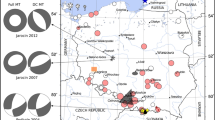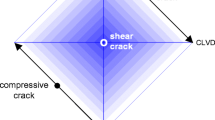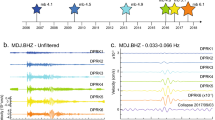Abstract
Human activities, including operations related to mining and reservoir exploitation, may induce seismicity and pose a risk for population and infrastructures. While different observations are commonly used to assess the origin of earthquakes, there is a lack of rules and methods for the discrimination between natural and induced seismicity. The inversion and decomposition of the full moment tensor and the observation of relevant deviation from a pure double couple (DC) model may be an indicator for induced seismicity. We establish here a common procedure to analyse a set of natural and induced events of similar magnitude, which occurred in Germany and neighbouring regions. The procedure is based on an inversion method and on a consistent velocity model and recording network. Induced seismicity is recorded during different mining and/or reservoir exploitations. Moment tensors are inverted using a multi-step inversion approach. This method, which was successfully applied in previous studies at regional and teleseismic distances, is further developed here to account for full moment tensor analysis. We first find a best DC solution and then perform a full moment tensor inversion, fitting full waveforms amplitude spectra at regional distances. The moment tensor solution is decomposed into DC, compensated linear vector dipole and isotropic terms. The discrimination problem is then investigated through the evaluation of distributions of non-DC source components for natural and induced data sets. Results illustrate the potential of the inversion and discrimination approach. Additional detailed analyses are carried out for the two most significant induced earthquakes, and rupture models are compared with the full moment tensor solutions.








Similar content being viewed by others
References
Ahorner L (1998) Entstehung und Ablauf des Gebirgsschlages von Völkershausen am 13. März 1989 in Kalibergbaugebiet des Werratals, Thüringen, aus seismologischer Sicht. Geol Jahrb E 55:25–46
Aki K, Richards PG (1980) Quantitative seismology. Freeman and Co., New York
Bernardi F, Braunmiller J, Kradolfer U, Giardini D (2004) Automatic regional moment tensor inversion in the European–Mediterranean region. Geophys J Int 157:703–716
Braunmiller J, Kradolfer U, Baer M, Giardini D (2002) Regional moment tensor determination in the European–Mediterranean area—initial results. Tectonophysics 356:5–22
Braunmiller J, Dahm T, Bonjer KP (2007) Source mechanism of the 1992 Roermond earthquake from surface-wave inversion of regional data. Geophys J Int 116:663–672
Buforn E, Pro C, Cesca S, Udias A, del Fresno C (2011) The 2010 Granada, Spain, deep earthquake. Bull Seismol Soc Am 101(5):2418–2430
Cesca S, Buforn E, Dahm T (2006) Moment tensor inversion of shallow earthquakes in Spain. Geophys J Int. doi:10.1111/j.1365-246X.2006.03073.x
Cesca S, Heimann S, Stammler K, Dahm T (2010) Automated procedure for point and kinematic source inversion at regional distances. J Geophys Res. doi:10.1029/2009JB006450
Cesca S, Dahm T, Juretzek C, Kühn D (2012) Rupture process of the 7 May 2001 M w 4.2 Ekofisk induced earthquake. Geophys J Int. doi:10.1111/j.1365-246X.2011.05151.x
Custodio S, Cesca S, Heimann S (2012) Fast kinematic waveform inversion and robustness analysis: application to the 2007 M w 5.9 Horseshoe Abyssal Plain, offshore SW Iberia, earthquake. Bull Seismol Soc Am 102(1):361–376
Dahm T, Kruger F, Stammler K, Klinge K, Kind R, Wylegalla K, Grasso JR (2007) The 2004 M w 4.4 Rotenburg, Northern Germany, earthquake and its possible relationship with gas recovery. Bull Seismol Soc Am 97:691–704
Deichmann D (2011) Earthquakes in Switzerland and surrounding regions 1996–2010. Version 2011.1 Swiss Sweismological Service-ETH Zürich, 176pp
Dreger SD, Ford SR, Walter WR (2008) Source analysis of the Crandall Canyon, Utah, mine collapse. Science 321:217
Dziewonski AM, Chou TA, Woodhouse JH (1981) Determination of earthquake source parameters from waveform data for studies of global and regional seismicity. J Geophys Res 86:2825–2852
Fischer T, Horálek J, Michálek J, Boušková A (2010) The 2008 West Bohemia earthquake swarm in the light of the WEBNET network. J Seismol. doi:10.1007/s10950-010-9189-4
Ford SR, Dreger DS, Walter WR (2009) Identifying isotropic events using a regional moment tensor inversion. J Geophys Res 114:B01306. doi:10.1029/2008JB005743
Gilbert (1970) Excitation of the normal modes of the earth by earthquake sources. Geophys J R Astron Soc 22:223–226
Hasegawa HS, Wetmiller RJ, Gendzwill DJ (1989) Induced seismicity in mines in Canada—an overview. Pure Appl Geophys. doi:10.1007/BF00874518
Heimann S (2011) A robust method to estimate kinematic earthquake source parameters. PhD Thesis, University of Hamburg, Hamburg, Germany
Hudson JA, Pearce RG, Rogers RM (1989) Source Type plot for inversion of the moment tensor. J Geophys Res 94(B1):765–774
Jost ML, Hermann RB (1989) A student's guide to and review of moment tensors. Seismol Res Lett 60:37–57
Julian BR, Miller AD, Foulger GR (1998) Non-double-couple earthquakes 1. Theory. Rev Geophys 36:4. doi:10.1029/98RG00716
Kass RE, Raftery AE (1995) Bayes Factors. J Am Stat Assoc 90:773–795. doi:10.2307/2291091
Krieger L, Heimann S (2012) MoPaD—moment tensor plotting and decomposition: A tool for graphical and numerical analysis of seismic moment tensors. Seismol Res Lett 83(3):589–595
Krüger F, Klinge K (2002) The 1996 Teutschenthal potash mine collapse: an unusual event with an unusual mechanism. In: Korn M (eds) Ten years of German seismic network (GRSN), Senate Commission for Geosciences, Report 25. Wiley-VCH, Weinheim
Leydecker G (1998) Beziehung zwischen Magnitude und Groesse des Bruchfeldes bei starken Gebirgsschlaegen im deutschen Kalibergbau - ein Beitrag zur Gefaehrdungsprognose. Z angew Geol 44, 1:22–25
Leydecker G, Grünthal G, Ahorner L (1998) Der Gebirgsschlag vom 13. März 1989 bei Völkershausen in Thüringen im Kalibergbaugebiet des Werratals—Makroseismische Beobachtungen und Analysen. Geol Jahrb E 55:5–24
Miller AD, Foulger GR, Julian BR (1998) Non-double-couple earthquakes 2. Observations. Rev Geophys 36:4. doi:10.1029/98RG00717
Minson SE, Dreger DS (2008) Stable inversion for complete moment tensors. Geophys J Int 174. doi:10.1111/j.1365-246X.2008.03797.x
Ottemöller L, Nielsen HH, Atakan K, Braunmiller J, Haskov J (2005) The 7 May 2001 induced seismic event in the Ekofisk oil field, North Sea. J Geophys Res 100. doi:10.1029/2004JB003374
Passarelli L, Maccaferri F, Rivalta E, Dahm T, Boku EA (2011) A probabilistic approach for the classification of earthquakes as ‘triggered’ or ‘not triggered’. J Seismol, submitted
Pondrelli S, Morelli A, Ekström G, Mazza S, Boschi E, Dziewonski AM (2002) European–Mediterranean regional centroid-moment tensors: 1997–2000. Phys Earth Planet Inter 130:71–101
Pondrelli S, Morelli A, Ekström G (2004) European-Mediterranean regional centroid-moment tensor catalog: solutions for years 2001 and 2002. Phys Earth Planet Inter 145(1–4):127–147
Pondrelli S, Salimbeni S, Morelli A, Ekström G, Boschi E (2007) European–Mediterranean regional centroid moment tensor catalog: solutions for years 2003 and 2004. Phys Earth Planet Inter 164(1–2):90–112
Rohr A (2011) Moment tensor inversion of induced earthquakes in Germany, Diploma Thesis, Univ. Hamburg, Germany, 138pp
Šílený J, Milev A (2008) Source mechanism of mining induced seismic events—resolution of double couple and non double couple models. Tectonophysics 456:3–15
Simpson DW, Leith W (1985) The 1976 and 1984 Gazli, USSR, earthquakes—were they induced? Bull Seismol Soc Am 75(5):1465–1468
Teyssoneyre V, Feignier B, Šílený J, Coutant O (2002) Moment tensor inversion of regional phases: application to a mine collapse. Pure Appl Geophys 159:111–130
Vavrycuk V (2001) Inversion for parameters of tensile earthquakes. J Geophys Res 106(B8):16.339–16.355
Wang R (1999) A simple orthonormalization method for stable and efficient computation of Green’s functions. Bull Seismol Soc Am 89(3):733–741
Wessel P, Smith WHF (1998) New improved version of the generic mapping tools released. Eos Trans. AGU 79, p. 579
Acknowledgments
We thank two anonymous reviewers, Dr. B. Dost, and Dr. L. Passarelli, and Dr. F. Krüger for valuable suggestions and S. Monna for revising the English text. We acknowledge the BGR and Dr. K. Stammler for providing fast and automated access to processed waveforms from German networks. The facilities of BGR, GEOFON and ORFEUS were used for accessing parts of the waveform and metadata required in this study. We acknowledge all institutions providing seismic data used in this research: GRSN (including stations from Bayern and Saxon seismic network), GEOFON, GEOSCOPE, MEDNET, Swiss Seismological Network, Czech Seismic Network, Austrian Seismic Network and GFZ project TOR. Figures were produced using GMT (Wessel and Smith 1998) and MoPaD (Krieger and Heimann 2012). This work has been funded by the project MINE. The project MINE is part of the R&D Programme GEOTECHNOLOGIEN. The MINE project is funded by the German Ministry of Education and Research (BMBF), grant of project BMBF03G0737.
Author information
Authors and Affiliations
Corresponding author
Rights and permissions
About this article
Cite this article
Cesca, S., Rohr, A. & Dahm, T. Discrimination of induced seismicity by full moment tensor inversion and decomposition. J Seismol 17, 147–163 (2013). https://doi.org/10.1007/s10950-012-9305-8
Received:
Accepted:
Published:
Issue Date:
DOI: https://doi.org/10.1007/s10950-012-9305-8




